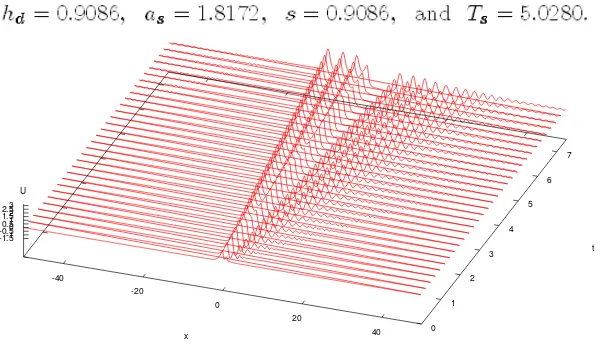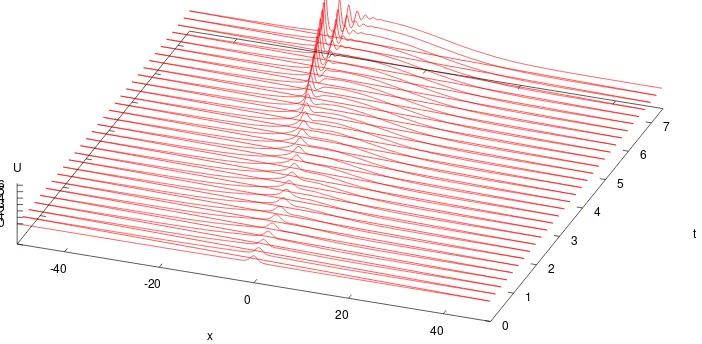Tsunami & Forced Korteweg de Vries Equation
(Tsunami & Persamaan Korteweg de Vries Paksaan)
Ong Chee Tiong
1, Loi Wei Sen
2, Choy Yaan Yee
3& Tay Kim Gaik
41
Faculty Science, Universiti Teknologi Malaysia.
2Faculty of Electrical Engineering, Universiti Teknikal Malaysia Melaka
3&4Faculty of Science, Technology and Human Development, Universiti Tun Hussein Onn Malaysia.
ABSTRACT
A systematic and comprehensive study of forced solitons in Tsunami waves that ca n be modelled mathematically by forced Korteweg-de Vries (fKdV). This equation have lost the translation-invariant type of group symmetries due to forcing. The traditional group-theoretical such as inverse scattering method, Backlund transformations and other known approaches can no longer generate a nalytic solutions of solitons, because there are no infinitely many conservation laws. Numerical simulations and approximate solutions seem the only ways to solve the forced nonlinear evolution equations. Numerical simulations of forced solitons will be implemented by a user-friendly software package FORSO. In this paper we show how approximate scheme can be used to generate forced solitons. Approximate solution also gives various profiles of fKdV such as the depth of depression zone; hd, amplitude;as, speed; s and the period; Ts of generation of forced solitons in Tsunami waves.
ABSTRAK
Penyelidikan ini adalah kajian yang sistematik dan menyeluruh tentang soliton paksaan dalam gelombang Tsunami yang boleh dimodelkan secara matematik oleh persamaan Korteweg-de Vries paksaan (fKdV). Persamaan ini telah hilang sifat translasi tak variannya dari simetri kumpulan kerana wujudnya paksaan. Kaedah tradisi dalam teori kumpulan seperti kaedah penyera kan songsang, transformasi Backlund dan pendekatan lain yang diketahui tidak lagi mampu menghasilkan penyelesaian analitik lagi, kerana tidak lagi wujud tak terhingga banyaknya hukum keabadian. Simulasi berangka dan penyelesaian hampir sahajalah satu-satunya cara yang boleh digunakan untuk menyelesaikan persamaan evolusi tak linear paksaan.Simulasi berangka untuk menjana soliton paksaan akan dilakukan dengan perisian komputer yang mesra pengguna iaitu FORSO.Dalam kertas kerja ini kita tunjukkan bagaimana penyelesaian hampir digunakan untuk menjana soliton paksaan.Penyelesaian hampir juga memberikan beberapa profil fKdV seperti kedalaman zon, hd, ampiltud;a s, laju; s dan tempoh; Tsbagi penjanaan soliton paksaan dalam gelombang Tsunami.
Keywords: Soliton, Tsunami, Korteweg de Vries
1.
Introduction
In the last ten years, several researchers have conducted extensive studies on Korteweg-de Vries (KdV)equation and they were able to get free solitons generated, Shen (1993). With forcing terms added to the original KdV equation, it has lost group symmetries and the traditional group-theoretical approach can no longer generate analytical solution of solitons, because there is no infinitely many conservation laws. Approximate solution and numerical simulation seem to be the only way to solve fKdV equations, Ong(2002). When a fluid flow interacts with a topographic feature, and the fluid can support wave propagation, then there is the potential for waves to be generated upstream or downstream. In many cases when the topographic feature has a small amplitude, the situation can be successfully described by using a linearized theory and any nonlinear effects are determined as a small perturbation on the linear theory. However, when the flow is critical, that is, the system supports a long wave with zero group velocity in the reference frame of the topographic feature, then the linear theory failed and hence an intrinsically nonlinear theory need to be developed. It is now known that in many cases such a transcritical, weakly dispersive theory leads to a good model for tsunami waves using fKdV equation., Ong(2002).
2.
Approximate Solution of
fKdV
Since there is no analytical solution for fKdV equation and we would like to understand the behavior of forced solitons in fKdV, therefore an approximate scheme will be developed to solve the fKdV model given by equation
(1)
In this case,( , )x t describes the free surface profile of the water flows over a bump,
measures the deviation of the bump speed from the shallow water velocity, is computed from the cross section area of the bump, whereas( )x x
is an isolated forcing function of Dirac-delta function, x is the spatial coordinate along the channel, t is time,
and are constants. The control parameters in this model are the bump size parameter
and the bump speed parameter .The initial condition for equation is ( ,0)x 0 which is the water surface profile at rest. The solution consists of a forced soliton region generated upstream with amplitude; a s and speed s, a depression region with depth hd immediately on the lee side of the bump and a lee diminishing cnoidal wave further downstream. Theschematic solution of equation is shown in Figure (1).
Figure 1: The Schematic Solution of fKdV Equation
The derivation of approximate solution of fKdV is done by observing the kth upstream soliton of the fKdV, Shen (1993), may be expressed in the following form
where
kis the specific phase shift for the kth soliton, s is the upstream advancing speed of the solitons and2(
)
s
a
s
is the amplitude of the soliton. For each soliton
( )k , with the first three conservation laws one hasBased upon the mass balance postulate that the upstream soliton mass comes solely from the downstream depression when time is sufficiently large, we have derived the approximate expressions of the depression depth hd, soliton amplitude a s, soliton propagation speed s, and soliton generation periodTsin terms of the control parameters
and
given as;1
2
2
( )
t
x
x
xxx
x
x
The forcing function in Equation (1) is a Dirac delta function which may due to the bottom topography of the fluid domain (such as a bump on the bottom of a two dimensional channel), or due to an external pressure on the free surface (such as the wind stress on the surface of an ocean). By taking 1and if we keep 0 so as to remain in the transcritical region we are able to observe the generations of forced uniform solitons as given by Figure (2) which shows the 3D plot of the forced uniform solitons propagations. The approximate solution of the nonlinear partial differential equation, fKdV profiles are given by;
-40
-20
0
20
40 x
0 1
2 3
4 5
6 7
t -1.5-1
-0.50 0.51 1.52 2.53 U
Figure 2: 3D plot of Dirac Delta Forcing –Tsunami Waves
In tsunami waves generation two most important physical measurement are a sandTs
.
These informations arevery important in order to decide if a warning system should be triggered in order to save more lives. Once an amplitude that is very close to the critical amplitude that can cause a tsunami warning, scientist in the meteorological department will then predict the arrival time of the tsunami using Ts
.
Accurate calculations are veryimportant to save more lives.
3.
Numerical Solution of
fKdV
Nouri and Sloan [6] studied six Fourier pseudo-spectral methods that solve the KdV equation numerically namely leap-frog scheme of Fornberg and Witham, semi-implicit scheme of Chan and Kerhoven, modified basis function scheme of Chan and Kerhoven, split-step scheme based on Taylor expansion, split-step scheme based on characteristics and quasi-Newton implicit method. They found that the semi-implicit scheme of Chan and Kerhoven [4] to be the most efficient of the methods tested. Chan and Kerhoven integrated the KdV equation in time in Fourier space using two Fast Fourier Transform (FFT) per time step. They also used Crank-Nicolson method for the linear term and a leap-frog method for the nonlinear term.
In solving fKdV equation we shall use pseudo-spectral method and we integrate the distance with leapfrog finite difference scheme in the spectral distance. We set the interval is from L x L where
L
is sufficiently large such that
(
x
L t
, )
(
x
L t
, )
0
. We start by transforming Equation (1) from L x L into 2
periodic withintroducing (x L) L
. Let,L
, it will transform
( , )x t into V( , )
t and we treat that nonlinear term such as 2W
V . Next, we reduced Equation (1) to be;By taking the Discrete Fourier Transform (DFT) of V( , )
t for j
0,1, 2,3,...,
N
1
and is given by;Similarly for the inverse Fourier Transform, is given by;
When we model the tsunami wave into fKdV equation the forcing term can be a Dirac-delta function, secant hyperbolic square, Gaussian and tangent hyperbolic. Similarly, we do discrete Fourier transform (DFT) for forcing
functions using the conditions above and by taking; tempi
3 3p t, we obtain;(3)
Next, take set the value of 3
4
, 16
and
2 and we use a user-friendly software package FORSO developed by Ong (2002) to obtain the graphical output using Dirac-delta forcing is shown as in Figure (2). Withsecant hyperbolic forcing given by we then obtain a very different type of waves phenomena as given in
Figure (3) and the 3D plot is given in Figure 4.
[image:4.595.84.491.84.192.2]
Figure 3: Secant Hyperbolic Forcing in Tsunami Waves t = 5.75s and t = 7.5s
-40
-20
0
20
40 x
0 1
2 3
4 5
6 7
t 0
1 2 3 4 5 6 U
[image:4.595.113.517.364.511.2] [image:4.595.141.492.566.738.2]4.
Conclusion
Approximate solution can be another scheme to solve fKdV equation. By knowing the various characteristics of those forced solitons generated we can be very sure of its nature. We also know the amplitude, speed, depth of the depression zone and the period of generation of forced uniform solitons. With known values of the control parameter
and
we do generates forced solitons and we know the profiles of each forced solitons generated is very close to tsunami waves generated by natural disaster like earthquake . With this new findings, we have another source to confirm our research results with other schemes namely the numerical simulation or even with the analytical solution of fKdV if ever found.Acknowledgement
We wish to thank RMC UTM for the financial support under research vot: FRGS 78525.
References
[1] Chan, T.F. and Kerhoven, T., “Fourier method with extended stability intervals for the Korteweg-de Vries
equation”, SIAM Journal Numerical Analysis Vol 22, 1985, pg 441-454.
[2] Nouri, F.Z. and Sloan, D.M., “A comparison of Fourier pseudo-spectral methods for the solution of the Korteweg-de Vries equation”, Journal Computational Physics Vol 83, 1985, pg 324-344.
[3] Ong, C.T. “Various Aspects of Solitons Interactions”, M.Sci. Thesis, Universiti Teknologi Malaysia, 1993. [4] Ong, C.T.“Development Of Numerical Package(FORSO) And Its Applications On Forced Korteweg-de Vries
And Other Nonlinear Evolution Equation”, P.hD. Thesis, Universiti Teknologi Malaysia, 2002. [5] Shen, S.S. “A Course on Nonlinear Waves”, Kluwer Academic Publisher, Boston, 1993.
[6] Whitham, G.B., “Lectures on Wave Propagation”, Springer-Verlag: Berlin, Heidelberg, New York, 1979.


